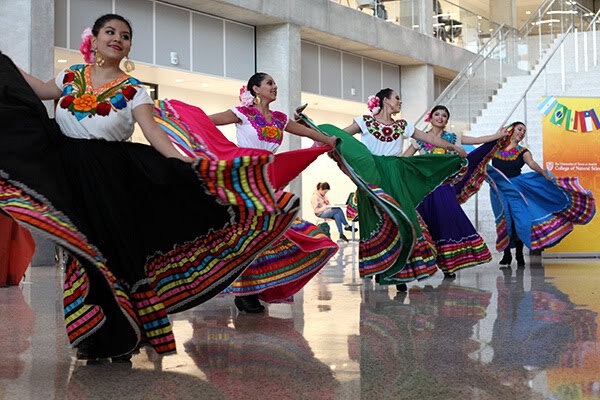Texas Folklorico dance to revive tradition

March 21, 2022
Editor’s Note: This article first appeared in the March 1, 2022 flipbook.
Fitted in his manta shirt, matching white pants and sombrero, Christopher Fierro tied a red bandana around his neck and took a deep breath, preparing himself for the stage. The rhythmic stomping drowned out the music, and dancers threw gritos across the stage as they entranced the audience with their synchronized moves.
The performance brought forth the culture and story of Huasteca, a region on the Gulf of Mexico, in a display of music, clothing and dance. Fierro said the purpose and beauty of ballet folklorico is to explore and showcase cultural pieces.
“It’s a style, it’s culture, it’s a language being expressed through our body,” the management senior said. “It’s so much more than dance — it’s about the emotion (and) connection with the pieces, understanding the origins. We relive history on stage.”
Ballet folklorico, the history of Mexico personified through dance, shares stories which encapsulate the traditional styles of Mexican dance. For Texas Folklorico members, performing offers an opportunity to connect with personal history, and share aspects of Mexican culture with the UT community. However, since the onset of the COVID-19 pandemic, the club struggled to maintain its on-stage energy, leaving dedicated members frustrated yet committed to rebuilding.
“Folklorico derives from different indigenous dances that were later modernized and structured to be projected in a theatrical aspect,” Fierro said. “It involves background understanding and immersion of the culture, rather than putting on shoes and tapping away.”
For Karla Cuellar Ramirez, a civil engineering and government senior, finding folklorico at UT helped ground her when she felt lost.
“(Folklorico) was a big part of my life,” Ramirez said. “Coming to UT my first year, I didn’t connect with the different organizations, there was something missing. Something that connected me to my roots, along with other people.”
After joining Texas Folklorico, Ramirez found her missing piece — a safe space where she could interact with her culture and feel a sense of belonging. Ramirez said she loves learning and sharing the significance behind every piece.
“It’s connecting with other states and people,” Ramirez said. “Everything varies by region, (which is) something I didn’t notice until I got into dance.”
When looking for a student organization to help her connect to traditional Mexican culture and dance, business freshman Ana Villicana said she felt like the options were limited, and she could only find groups that performed renditions of modern Latin dances, such as bachata.
“It’s not just Bad Bunny type of dancing,” Villicana said. “There’s no traditional Hispanic dances, there isn’t that for us.”
Then she discovered folklorico. Entranced by the rhythmic stomps and vibrant dresses, Villicana fell in love with how the group performed her culture.
“It’s bringing the (Mexican) tradition into (the folklorico club),” she said. “It’s my history.”
Forced to practice and perform online for the majority of 2020, Fierro said they struggled to find rehearsal spaces, and could not convey passion through screens. Fierro said while folklorico clubs at UT faced adversity in the past, a lack of resources and sponsors due to COVID-19 made matters worse, leading to the club’s disbandment in late 2020.
“We ran into problems, being able to transmit emotion and connection with the pieces and the origins to an audience was difficult,” Fierro said.
Fierro and Ramirez said that while they cannot rebuild Texas Folklorico alone, they hope to attract students, specifically underclassmen, to continue the tradition and bring the light of Mexico into the heart of Texas.
“I’m here to help out and make this happen,” Fierro said. “It’s a goal of mine to leave something (at UT). Folklorico is the way to do that, a perfect way to know Mexican culture and understand it.”











